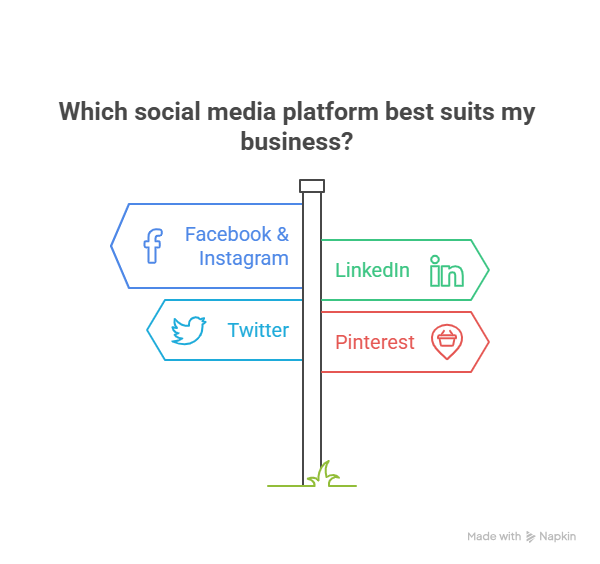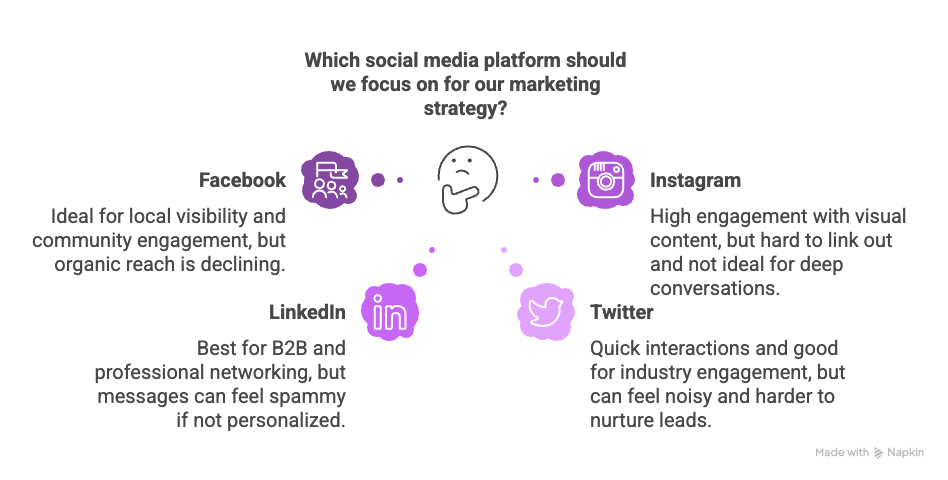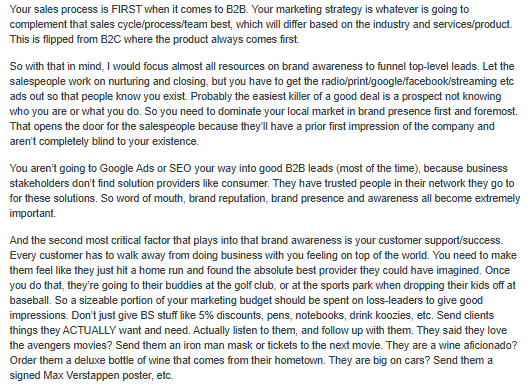Table of Contents
Reaching out to small businesses on social media is a whole different thing compared to selling to big companies. You’re not pitching to faceless corporations with layers of procurement. You’re trying to connect with owners, operators, or lean marketing teams, juggling ten things before lunch.
They don’t have time. And they definitely don’t want to be "nurtured" with cold, generic DMs.
But that’s also the opportunity. When you get it right (when your outreach is timely, personal, and relevant), SMBs respond faster, engage more openly, and convert with less red tape. Your outreach has the potential to genuinely impact the bottom line,
You’ve got to do your homework. You’ve got to show up where they are and speak their language.
TL;DR: Social Media Outreach Strategies for B2SMB
- Most small businesses won’t respond to generic pitches. You need to sound like a real person who actually did some homework about them.
- Use hashtags, keyword searches, and tools like Hootsuite or ProspectUp to find SMBs that are active and worth reaching out to.
- Post helpful, specific content—short wins, how-tos, and behind-the-scenes stuff. No fluff. Just what actually works for other small businesses.
- Keep your DMs short and personal. Mention something they’ve posted or achieved. Skip the sales pitch.
- Before messaging, engage with their posts. Like, comment, maybe share. Make your name familiar before sliding into inboxes.
- Paid ads can help, but don’t overdo it. Use retargeting for people who have already shown interest.
- When someone replies, respond quickly and keep the tone light. Offer value. Then suggest a call if it feels right.
- ProspectUp helps you cut the guesswork—find SMBs, see who’s active, and send better outreach without wasting time.
Finding Your Target SMB Accounts on Social
Social media has revolutionized the way businesses engage with one another. For companies aiming to connect with small to medium-sized businesses, building a strategy that prioritizes social media is key to success.
So, before you send that message or launch that campaign, pause.
Why Targeting is Critical
Reaching out to everyone willy-nilly may get you a couple of responses, but you probably know that’s not smart, resource-efficient, or sustainable. You need to know who you’re talking to, what they care about, and where they hang out online.
The more targeted your approach, the more likely you are to get meaningful replies, not ghosted DMs.
That’s where smart targeting pays off. It:
- Increases engagement by speaking their language.
- Saves time and budget by avoiding irrelevant leads.
- Boosts conversions with context-aware messaging.
Tools & Techniques for Discovery
So, how do you actually find these SMBs? Here’s where the fun begins.
- Social Listening Tools
You don’t have to stalk every business manually. Tools like Buzzsumo and others can help you track mentions of small business keywords, hashtags, or specific industries. These platforms allow you to monitor trends, competitor chatter, or posts from decision-makers in real time.
Want to know who’s talking about “commercial cleaning services” in Melbourne? Set an alert. You’ll get pinged every time someone mentions it. You can also do this using free tools like Google Trends.
- Hashtag and Keyword Searches
Start simple. Use platform-native search bars (especially on LinkedIn, Twitter, and Instagram) and look up hashtags like:
- #SmallBusiness
- #LocalBusiness
- #B2Bservices
- #ShopSmall
- Industry-specific hashtags like #RealEstateAgents or #AutoRepairLife
You’ll find many accounts actively promoting their services, asking for recommendations, or simply posting content to show they’re still active.
- ProspectUp Does the Heavy Lifting
You don’t have to go full detective mode either. ProspectUp gives you 100+ data points about your leads, including:
- Social media presence
- Verified contact info
- Business size and location
- Their latest updates and offers
With this data, you can prioritize the SMBs worth targeting and skip the ones with zero social footprint. ProspectUp even links you directly to their social handles, so you can follow, like, and slide into their inbox the right way.
Platform Selection: Where to Engage Your SMB Prospects
Now that you’ve found the right SMBs, where should you reach out?
Not every platform is the same.
Each one attracts different types of businesses, tons of communication, and outreach strategies. Picking the wrong one is like selling accounting software on TikTok. It might work, but it’s an uphill climb.
Platform Fit: What Works Best Where?

Here’s a cheat sheet:
Facebook & Instagram
Great for: Local stores, beauty salons, restaurants, lifestyle, and retail SMBs.
Why: These platforms are visual, personal, and loaded with location-based features like check-ins, reviews, and geo-targeted ads.
Pro Tip: Run story polls, tag their business in posts, or engage with their live sessions. Show up in their comments. Respectfully, of course.
Great for: Professional services, B2B SaaS, consultancies, marketing agencies.
Why: It’s the digital Rolodex of SMB decision-makers. They’re there to connect, learn, and grow their businesses.
Pro Tip: Use LinkedIn Sales Navigator to filter companies by headcount, industry, and geography. Then reach out with a short, punchy, non-salesy message like:
“Hey Emma! Saw you run a branding agency in Perth. Love your recent post on logo design. I'm curious. What’s the biggest challenge you’re facing with client acquisition?”
Great for: Tech startups, niche industries, community-based SMBs.
Why: It’s fast, hashtag-heavy, and filled with direct access to founders, marketers, and small business operators.
Pro Tip: Jump into threads or reply to relevant tweets with genuine comments. Don’t pitch. Add value. Build trust.
Great for: Designers, lifestyle brands, handmade products, food and beverage.
Why: Pinterest users are often planners and buyers. A small home décor business or bakery that posts pin-worthy content can be a smart outreach target.
Pro Tip: Use boards and pins to see what trends are catching on in a niche, then engage the original posters or link to their website via ProspectUp insights.
Pros & Cons of Each Platform

Pros: Great for local visibility. Community engagement. Ads work well.
Cons: Organic reach is declining. Needs regular posting.
Pros: High engagement with visual content. Good for brand awareness.
Cons: Hard to link out. Not ideal for deep conversations.
Pros: Full of professionals. Best for B2B. Filtering tools are powerful.
Cons: Messages can feel spammy if not personalized.
Pros: Quick interactions. Good for industry engagement and thought leaders.
Cons: Can feel noisy. Harder to nurture leads.
Pros: Long content shelf life. Great for creatives.
Cons: Limited messaging capabilities. Not suitable for every SMB.
Crafting Your Social Media Content Strategy
If you’re reaching out to small business owners, your content better look like you know what you're talking about.
They don’t have time to dig through a bunch of vague posts. They scroll fast and decide faster. So your content needs to earn attention immediately and show some kind of value without sounding like you’re selling every two seconds.
What Kind of Content Works for SMBs?
Not thought leadership. Not AI quotes. And definitely not long-winded posts about “the future of B2B engagement.”
What works:
- Tactical, how-to content with real results
Instead of “7 tips to grow on Instagram,” show this:
“Helped a local car wash in Adelaide get 48% more DMs using Stories + geo tags.”
That’s specific. That’s believable. That works.
- Screenshots of results or examples
Show dashboards. Before/after shots. A client’s post that got traction. Real screenshots are 10x better than stock graphics. Bonus if you add short context.
- Behind-the-scenes of your process
Don’t just say you build campaigns. Show how you test hooks. What tools you use. Your Notion board. A Loom video walk-through. SMBs trust people who show their work.
- Short, unfiltered videos
Nothing fancy. Just straight-talking videos from a founder or strategist saying:
“We tried this offer structure last week for a local physiotherapy client. This is what happened.”
Then break it down. 60 seconds is enough.
Outreach Messaging & Engagement Tactics
So, you’ve posted good content. Now it’s time to reach out.
The problem is that most outreach messages sound like a stranger trying to book a meeting for no reason.
If your DM doesn’t feel like it came from a real person who actually checked out the business, it’s going straight to “Ignore.”
Refined Approach & Brand Awareness
A successful B2SMB (Business-to-Small-Medium-Business) outreach strategy is built on consistency. As one industry expert puts it, the key to effective outreach lies in a well-organized approach that keeps the sales process flowing smoothly:

https://www.reddit.com/r/marketing/comments/1eye7fl/whats_the_best_b2b_marketing_strategy_of_2024/
They're absolutely right.
The true power of social media in B2SMB outreach is not only in promoting your product or service but also in showcasing the positive impact you've had on others. By celebrating your wins and elevating the stories of your customers, you create a powerful narrative that resonates with your audience.
What Makes a Message Worth Replying To?
You need four things:
- Personal context
- Business relevance
- A light ask (or no ask)
- A reason to trust you
LinkedIn DM Example (Simple and Direct):
“Hi Sarah, noticed you just opened a second location in Brisbane. Congrats! I help local service businesses build repeat bookings through Instagram. Thought it might be relevant. Are you open to a quick exchange?”
That’s it. No calendar link. No 4-paragraph pitch. Just a reason to talk.
For Twitter/X:
“Loved your thread on being a one-person marketing team. Been working with small brands facing the same issue. Mind if I send a few resources your way?”
Offer value. Ask permission. You’ll get way more replies.
Use Multiple Channels, But Use Them Properly
No one wants to be bombarded with an ad, a direct message, and an email all in the same day. Instead, space out your outreach to allow for natural engagement.
Start by liking and commenting on their recent post, mentioning something you genuinely found useful. Give it a day or two before sending a message, making it feel more like a continuation rather than a cold pitch.
Paid Campaigns That Aren’t Awkward
Use remarketing to show case studies, short videos, or quick tips. Keep it low-cost and narrow.
Example: Run a video ad targeting people who visited your “Book a Call” page but didn’t convert. The video should simply say:
“Still exploring? Here’s how we helped a local service business triple its leads with DMs. Check it out.”
No hard CTA but context.
What Happens After They Reply?
This is where many people drop the ball. Someone replies and then gets ignored, or worse, hit with a tone shift.
Keep it casual. Keep it helpful. Keep it moving.
- Acknowledge what they said
- Offer one idea or the next step
- Don’t force a call. Make it optional
Use tools like ProspectUp to track who’s engaged, what links they clicked, and when they last interacted. That helps you follow up without being weird.
Cold Outreach on Social Platforms
Cold outreach isn’t dead. But lazy outreach is.
If you’re reaching out to an SMB, remember, they’re used to getting pitched all the time. But they’re also open to help, especially if it sounds like it was written by someone who knows their business.
Tips that Work:
- Don’t open with “Hope you’re doing well”
Instead, start with something about them.
“Noticed you launched a new weekend promo…”
“Your recent post on delayed projects hit home…”
Start from them. Not you.
- Keep it to 2 lines
Max.
“Helped a similar business boost web traffic with one offer tweak. Happy to share if you’re curious.”
That’s all you need.
- Use a free resource as your soft entry
“Wrote up a short guide for small retail brands trying to grow on Instagram. Want me to send it over?” This works well because it offers value without asking for anything.
- Follow up once. Then stop.
Don’t chase people with four nudges. Send one friendly follow-up a few days later.
“Just checking in. Happy to close the loop if now’s not a good time.”
That’s clean and respectful. People appreciate that.
Summing Up…
If you’re serious about social media outreach for B2SMB, start with real content. Talk like a person. Show up where your prospects already are. And focus on conversations, not conversions. The rest will follow.
And if you want a smarter way to find small business leads, know who’s worth reaching out to, and write messages that get replies, ProspectUp makes that easy. Start building relationships, not just sending cold DMs.
Social Media Outreach Strategies for B2SMB: FAQs
What is the meaning of social media outreach?
Social media outreach is using platforms like LinkedIn, Twitter, or Instagram to connect directly with potential customers, partners, or industry peers. For B2SMB, that means building relationships with small and mid-sized businesses through comments, DMs, shared content, and personalized messaging. The goal isn’t to spam but start conversations that lead to actual business.
What is the best form of outreach?
There’s no one-size-fits-all, but the best outreach is always personal, relevant, and timed right. For small business audiences, that might mean commenting on a post before sending a message, or sharing a helpful resource before asking for a call. Outreach that feels like a conversation, not a cold pitch, is what actually works.











